Butter Dishes - Part II
by Mark A. Nye
Issue No. 175 - November 1987
It seems like ages since I first wrote about Cambridge butter dishes for the Crystal Ball, and in fact it was nine months ago that Part I of this series appeared.
At that time we covered butter dishes produced between the late 1920s and the final plant closing. This month we turn back the clock to the early years of production at the Cambridge Glass Company plant on Morton Avenue - a period when butter dishes were a more common item in Cambridge pattern lines.
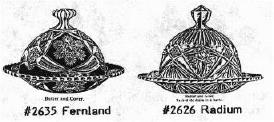 During the years 1903-1906, there were at on time or another, at
least 16 different butter dishes produced by Cambridge. During these
early years many patterns being produced were not named and, in fact,
of the 16 butter dishes from this time period, only two had names
appearing on catalog pages. These two were #2635, Fernland and #2626
Radium, both of which first appeared in the 1906 catalog (photo, left) and no doubt
were original Cambridge designs.
During the years 1903-1906, there were at on time or another, at
least 16 different butter dishes produced by Cambridge. During these
early years many patterns being produced were not named and, in fact,
of the 16 butter dishes from this time period, only two had names
appearing on catalog pages. These two were #2635, Fernland and #2626
Radium, both of which first appeared in the 1906 catalog (photo, left) and no doubt
were original Cambridge designs.
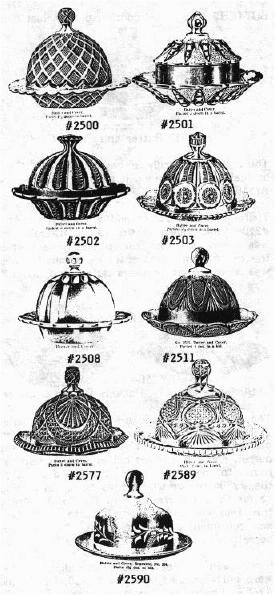 Lines shown in the 1903 Cambridge catalog that included a butter
dish among the available items were #2500, #2501, #2502, #2503, #2504,
#2508, #2510, #2511, #2577, #2589 and #2590 (most shown at right). It is the opinion of this
writer and one held by others that none of these designs were original
to the Cambridge Glass Company; rather they were patterns first
produced at other National Glass Company plants in prior years. It is
known that the Cambridge #2510 line (shown in the 1903 Cambridge
catalog) was first introduced by the Central Glass Company of
Summitville, Indiana in 1898. (This company should not be confused with
the better known Central Glass Company of Wheeling, WV.) After the
National Glass Company was founded, this pattern was also made by the
Indiana Tumbler and Goblet Works at Greentown, Indiana, in both clear
and a transparent blue. Retailers of this line included Sears &
Roebuck, as it was shown in their 1901 and 1902 catalogs.
Lines shown in the 1903 Cambridge catalog that included a butter
dish among the available items were #2500, #2501, #2502, #2503, #2504,
#2508, #2510, #2511, #2577, #2589 and #2590 (most shown at right). It is the opinion of this
writer and one held by others that none of these designs were original
to the Cambridge Glass Company; rather they were patterns first
produced at other National Glass Company plants in prior years. It is
known that the Cambridge #2510 line (shown in the 1903 Cambridge
catalog) was first introduced by the Central Glass Company of
Summitville, Indiana in 1898. (This company should not be confused with
the better known Central Glass Company of Wheeling, WV.) After the
National Glass Company was founded, this pattern was also made by the
Indiana Tumbler and Goblet Works at Greentown, Indiana, in both clear
and a transparent blue. Retailers of this line included Sears &
Roebuck, as it was shown in their 1901 and 1902 catalogs.
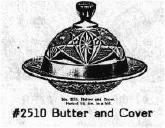 Thus, it was hardly a new line when Cambridge began producing it at
their plant as the #2510 line illustrated at left.
Thus, it was hardly a new line when Cambridge began producing it at
their plant as the #2510 line illustrated at left.
There were two butter and cover styles in the #2504 Line (below left) shown in the 1903 catalog. One was simply listed as "Butter and Cover" while the second, and apparently much smaller one, was described as "Packers Butter and Cover."
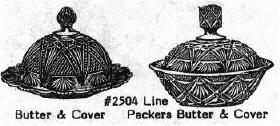 The packers butter is assumed to be smaller than the regular butter
since the latter was packed only four and a half dozen to the barrel,
and the packers butter was packed ten dozen to the barrel. The 1906
catalog listed the #2504 packers butter as being packed 12 dozen to the
barrel and in the 1910 catalog this item was called a small butter and
cover and continued to be packed at 12 dozen per barrel.
The packers butter is assumed to be smaller than the regular butter
since the latter was packed only four and a half dozen to the barrel,
and the packers butter was packed ten dozen to the barrel. The 1906
catalog listed the #2504 packers butter as being packed 12 dozen to the
barrel and in the 1910 catalog this item was called a small butter and
cover and continued to be packed at 12 dozen per barrel.
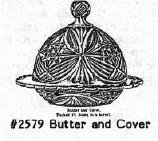 First seen in the 1906 Cambridge catalog were butter dishes from the
#2700, #2579 and #2625 lines;
as well as the previously mentioned
Fernland and Radium lines. Of these five, probably the #2579 was the
only one not designed by or for Cambridge.
First seen in the 1906 Cambridge catalog were butter dishes from the
#2700, #2579 and #2625 lines;
as well as the previously mentioned
Fernland and Radium lines. Of these five, probably the #2579 was the
only one not designed by or for Cambridge. 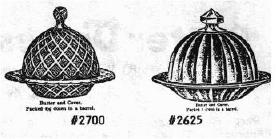 The molds most likely
originate from another National Glass Company plant.
The molds most likely
originate from another National Glass Company plant.
The 1910 Cambridge general catalog carried illustrations of 16 butters and covers with only three dating to the 1903-1906 period; these being #2504, #2508 and #2635 Fernland.
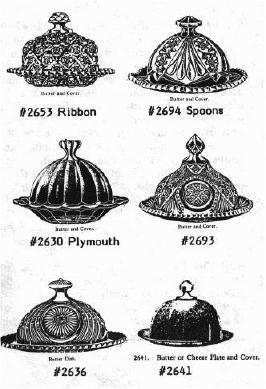 Among the 1910 patterns that included butters were several destined
to become quite well known to collectors. These patterns included #2570
Colonial, #2651 Feather, #2660 Wheat Sheaf and #2631 Marjorie. With the
exception of Colonial, no names were used in the 1910 Cambridge
catalog. Only the Line numbers appeared.
Among the 1910 patterns that included butters were several destined
to become quite well known to collectors. These patterns included #2570
Colonial, #2651 Feather, #2660 Wheat Sheaf and #2631 Marjorie. With the
exception of Colonial, no names were used in the 1910 Cambridge
catalog. Only the Line numbers appeared.
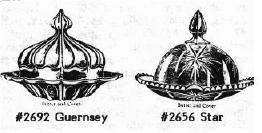 Other butters shown in the 1910 catalog were from the Lines #2692
(Guernsey), #2656 (Star), #2647 (Dorothy), #2653 (Ribbon), #2694
(Spoons), #2630 (Plymouth), #2693, #2636 and #2641.
Other butters shown in the 1910 catalog were from the Lines #2692
(Guernsey), #2656 (Star), #2647 (Dorothy), #2653 (Ribbon), #2694
(Spoons), #2630 (Plymouth), #2693, #2636 and #2641.
The Feather butter is unique among the 1910 butters in that it will be found in purple Carnival as well as crystal.
The #2656 Line was in production as early as January 1908, since a trade journal published that month carried Cambridge advertisements in which this Line was called "Near Cut Star Design" and "Star." There is no question that this is the pattern referred to since a 6 oz. tall sundae was shown and identified by line number. In the 1910 catalog no name was provided, but the following description was used in conjunction with this design: "Cut Sunburst very clear, fine in shape and most desirable for the trade where a clean, attractive pattern is wanted at a reasonable price."
This #2656 line is known to Pattern Glass collectors as Star of Bethlehem. The design consists of a star with either six or eight points and associated rays. The butter dish and some other pieces have an eight pointed star while the majority of the items in the line have a six-pointed star. The #2656 line is known with ruby flashing and gold edges. The star, however, remains clear.
A nice feature of the 1910 catalog is that it incorporated a price list into the body of the catalog. Thus, we know that in 1910, the Marjorie butter and cover sold to the trade for $3.20 per dozen. This was the highest price in this catalog for a butter and cover. The Feather butters were less expensive at $2.20 per dozen.
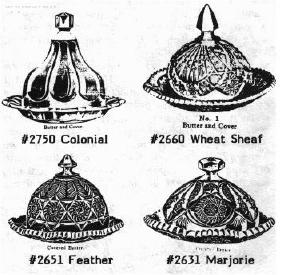 The next known general Cambridge catalog is from circa 1917 and
within its pages five butters from previous catalogs are illustrated.
These being the ones from the #2631 Marjorie, #2750 Colonial, #2630
Plymouth, #2660 Wheat Sheaf and the #2590 lines. At least three of
these butter dishes, those from the #2750 Colonial, #2630 Plymouth and
#2660 Wheat Sheaf lines, were still in production when the 1920s
dawned. However, by 1930 all of these early lines, with the exception
of a few individual pieces (none of which were butter dishes), had been
discontinued.
The next known general Cambridge catalog is from circa 1917 and
within its pages five butters from previous catalogs are illustrated.
These being the ones from the #2631 Marjorie, #2750 Colonial, #2630
Plymouth, #2660 Wheat Sheaf and the #2590 lines. At least three of
these butter dishes, those from the #2750 Colonial, #2630 Plymouth and
#2660 Wheat Sheaf lines, were still in production when the 1920s
dawned. However, by 1930 all of these early lines, with the exception
of a few individual pieces (none of which were butter dishes), had been
discontinued.
The first pieces of the #2800 Community Crystal design were shown shortly after 1910. By 1915-1917, there was an extensive array of items in this line, including stemware, footed sherbets, vases, nappies and table sets which included a covered butter dish. The #2800 line, in fact, featured not one, but three covered butters, illustrated at right.
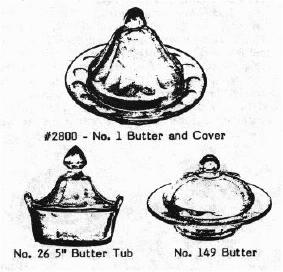 All three of these butters were being produced in the early 1920s
but sometime in the mid-1920s and before 1927, the Community line was
discontinued. In the late 1930s the stemware was put back into
production, but there is no evidence that the butter dish was reissued.
All three of these butters were being produced in the early 1920s
but sometime in the mid-1920s and before 1927, the Community line was
discontinued. In the late 1930s the stemware was put back into
production, but there is no evidence that the butter dish was reissued.
 In addition to the covered butters, the #2800 line featured two
individual butter pats as shown at left.
In addition to the covered butters, the #2800 line featured two
individual butter pats as shown at left.
Slightly similar in design to the #2800 Community line, but with different shaped pieces, is the #2892 or Guernsey Semi-Colonial design and it is from this line that our next butter dish comes. (Editor's Note: This #2892 line is exactly the same as the #2692 line.) The top to the butter from this line is reminiscent of a Moorish style dome. Introduced sometime between 1910 and 1917, it appears the #2892 line was most likely discontinued prior to 1920 and definitely was out of production by 1927.
There are several basic design elements that were and are used in several different ways to decorate glass, imparted by the mold, i.e. pressed or molded patterns, engraved or rock crystal cuttings, and cutting as it is known as cut glass. Similar patterns using these basic designs, for example Thumb Print, Sunburst, and Buzz Saw were developed by several companies and this often creates problems for today's students of glass. Even though they use the sunburst and buzz saw theme respectively, our next two butter dishes were definitely pressed by Cambridge since we have catalog pages showing the actual pieces with the patterns as developed by Cambridge.
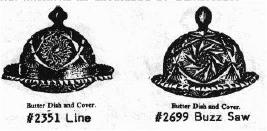 Little is known about the #2351 design (left), described in a Cambridge
catalog only as "Heavy Pressed." Its main design element is a sunburst
and it was probably first shown by Cambridge circa 1915. The line,
along with the butter dish is shown in a catalog issued sometime after
1915. For the most part, the pattern had been discontinued by 1920; the
punch bowl and shakers being two known exceptions.
Little is known about the #2351 design (left), described in a Cambridge
catalog only as "Heavy Pressed." Its main design element is a sunburst
and it was probably first shown by Cambridge circa 1915. The line,
along with the butter dish is shown in a catalog issued sometime after
1915. For the most part, the pattern had been discontinued by 1920; the
punch bowl and shakers being two known exceptions.
Cambridge actually referred to the #2699 line as the "Buzz Saw Design." #2699 Buzz Saw (above) was probably introduced by Cambridge during the years between 1910 and 1915 and continued in the Cambridge line until sometime after 1921. The butter dish from this line was pictured in both the circa 1915-1917 catalog and the circa 1920 catalog. The buzz Saw pattern was one Cambridge called a "Medium Pressed" design. It is generally accepted these terms, along with "Light Pressed," were used by Cambridge to indicate the depth of the pattern in the glass, "Heavy," of course, being the deepest.
To be continued ...
